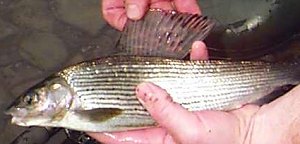Because of their limited distribution in British waters, grayling fishing is restricted to anglers who live near (or who travel to) the unpolluted rivers and streams where the fish are found. Those fortunate enough to be able to catch grayling will agree that there are few more beautiful fish and none which offer such exciting sport in the coldest of weather. ‘Lady of the Stream’ is indeed an apt description.

Sailing away
There is no mistaking a grayling: its definitive characteristics are the huge, sail-like fin (larger in males), which is used to good effect in combatting fast currents, and the small adipose fin further along its back, indicative of salmonid species. Like most actively swimming fish, grayling have deeply-forked tails. Their heads are small and pointed, and the jaws carry very small teeth – to hold the insects, crustaceans and even fish fry on which they feed. Water snails also figure prominently in their diets.
Spot the fish
The flanks of a grayling’s elongate but solid body are silvery, with steel/blue shading, and the sides are marked with violet-coloured stripes which darken at spawning time. Irregular dark spots occur on the fins and the flanks, and the number and position of these markings are unique to individual fish.
Short life
The life-span of grayling is far shorter than that of brown trout or coarse fish, and they rarely live longer than seven or eight years. Spawning occurs in shallow, gravel runs, where the fish construct depressions (or redds) in the bed into which the eggs are laid, then covered in gravel.
Keep it clean
Although natural populations occur in some deep lakes, grayling flourish in cool, fast-flowing waters. They tend to group in shoals, and large catches can be taken once these shoals have been located by adopting roving tactics. Freshly-caught grayling have a thyme-like smell and make excellent eating, but nowadays most anglers prefer to return their fish alive to the water. As game fishery owners have adopted more enlightened, informed attitudes to the presence of grayling in trout fisheries, the sickening culls of these obliging fish have become largely a thing of the past.
–*–
If you are interested in cheap grayling fishing tackle and bait, please click here.




















